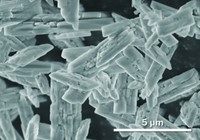Advertisement
Grab your lab coat. Let's get started
Welcome!
Welcome!
Create an account below to get 6 C&EN articles per month, receive newsletters and more - all free.
It seems this is your first time logging in online. Please enter the following information to continue.
As an ACS member you automatically get access to this site. All we need is few more details to create your reading experience.
Not you? Sign in with a different account.
Not you? Sign in with a different account.
ERROR 1
ERROR 1
ERROR 2
ERROR 2
ERROR 2
ERROR 2
ERROR 2
Password and Confirm password must match.
If you have an ACS member number, please enter it here so we can link this account to your membership. (optional)
ERROR 2
ACS values your privacy. By submitting your information, you are gaining access to C&EN and subscribing to our weekly newsletter. We use the information you provide to make your reading experience better, and we will never sell your data to third party members.
Materials
Bringing Disorder To Titanium Dioxide
Change allows the photocatalyst to absorb beyond the ultraviolet range, into visible and infrared spectrum
by Bethany Halford
January 24, 2011
| A version of this story appeared in
Volume 89, Issue 4
By hydrogenating titanium dioxide nanocrystals, researchers have engineered disorder into the material—a change that appears to enhance TiO2’s properties so that it absorbs beyond the ultraviolet range into the visible and infrared spectrum (Science, DOI: 10.1126/science.1200448). The transformation could expand TiO2’s use as a photocatalyst for a variety of solar-driven clean energy and environmental technologies. A team led by Samuel S. Mao, of Lawrence Berkeley National Laboratory and the University of California, Berkeley, devised the concept of disorder engineering and used a hydrogenation process so that it produces TiO2 with a crystalline core and a highly disordered surface layer. The core maintains TiO2’s catalytic properties while the surface enhances visible and infrared absorption, promoting catalytic activity. The material also undergoes a dramatic color change during hydrogenation, from bright white to black. The researchers show the disordered material is capable of photooxidizing organic molecules in water and can produce hydrogen from water and sunlight at high efficiency.




Join the conversation
Contact the reporter
Submit a Letter to the Editor for publication
Engage with us on Twitter